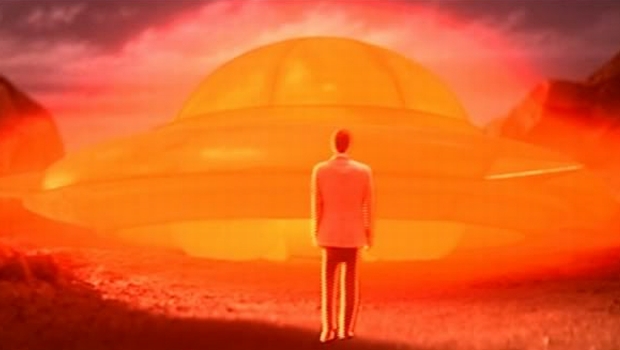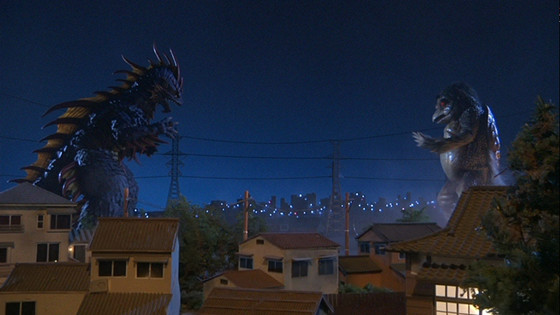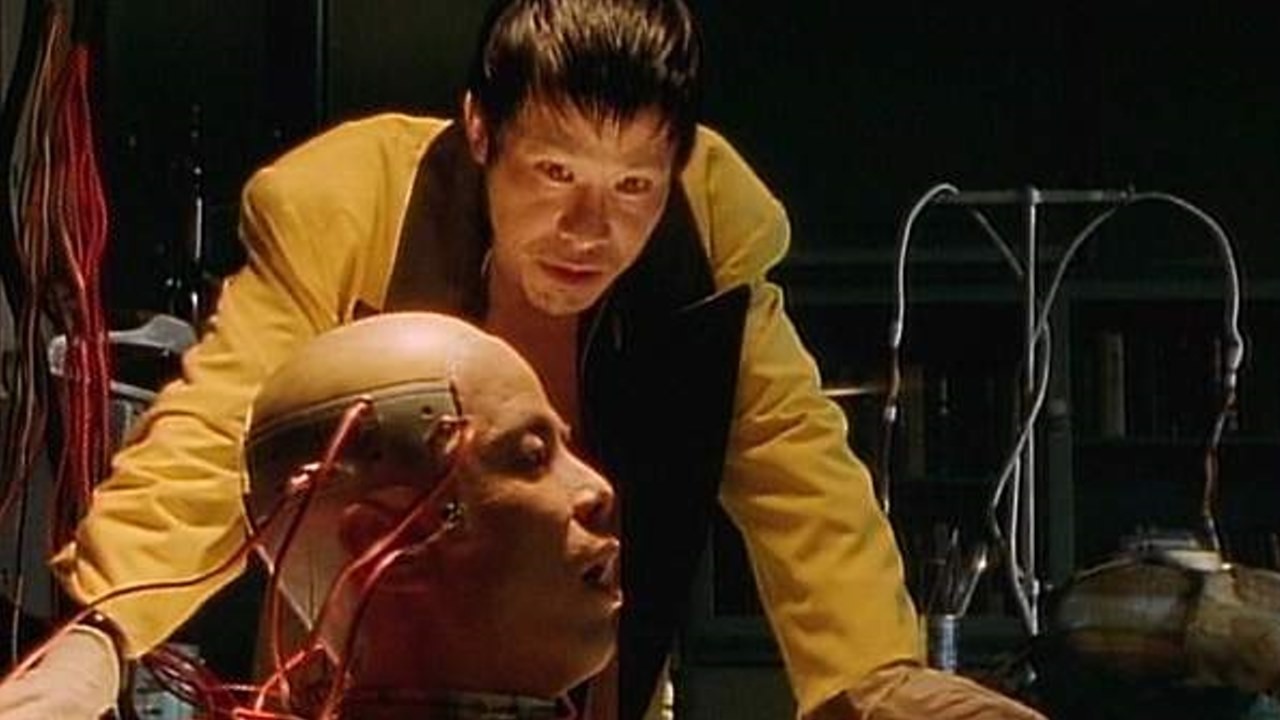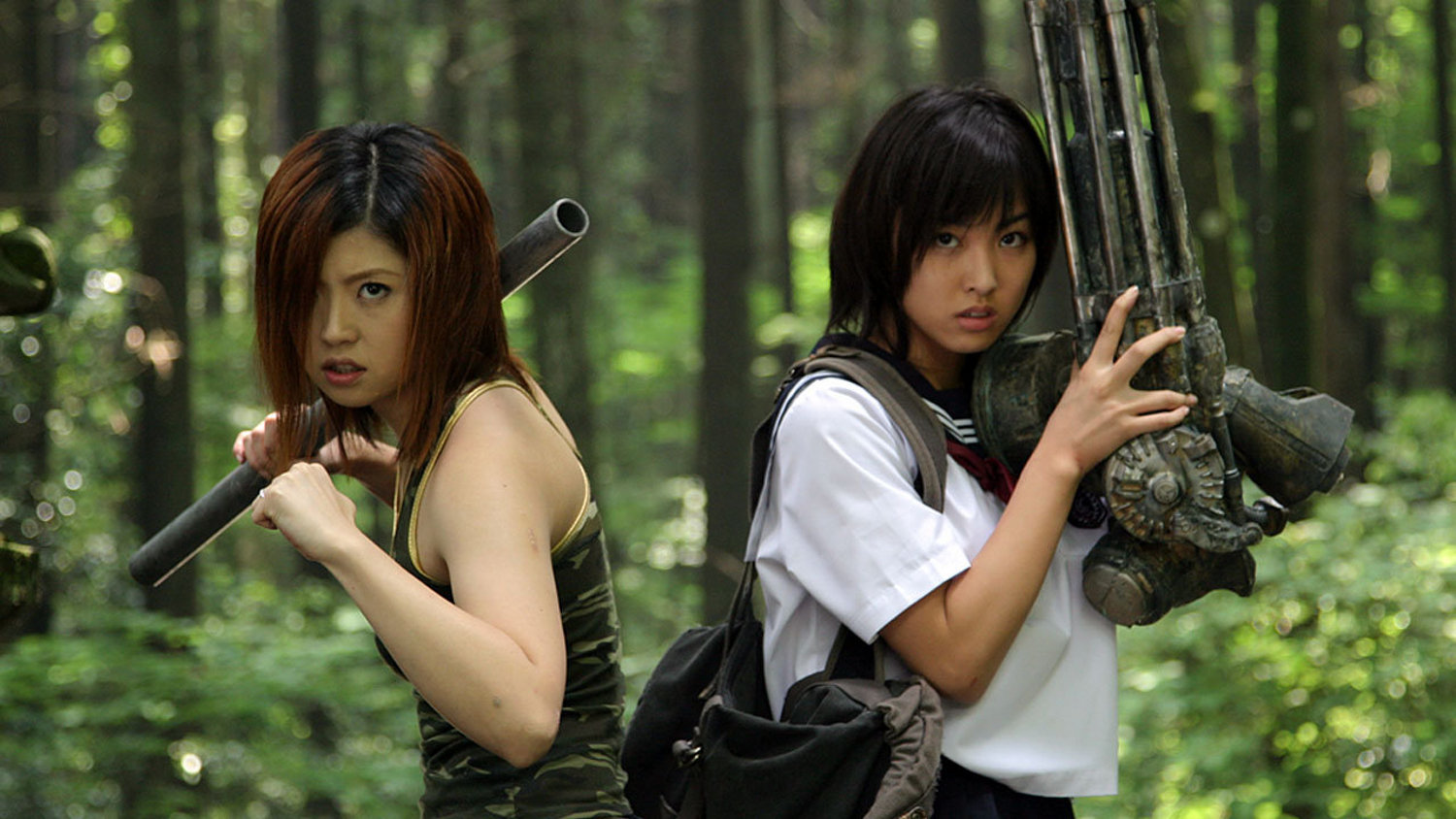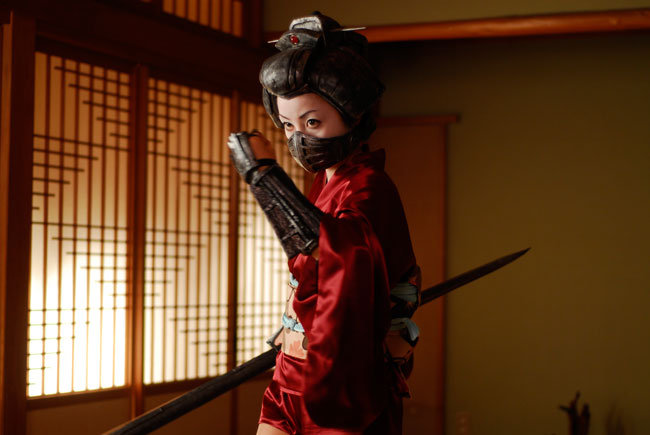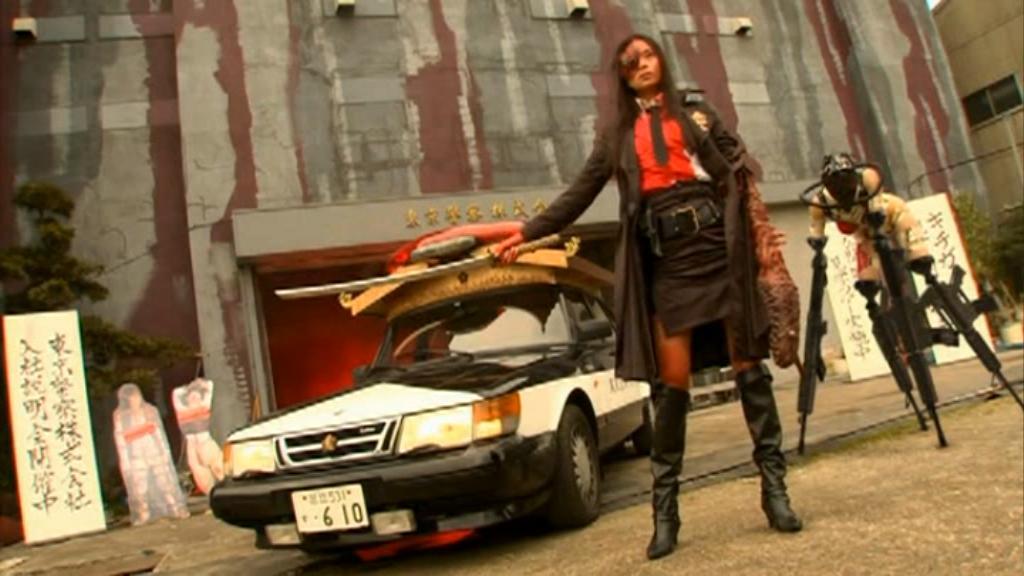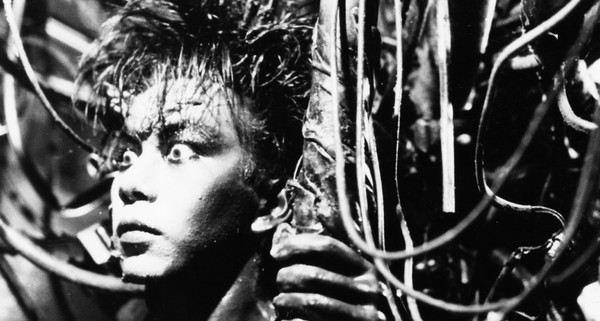8. Goke, The Body Snatcher From Hell
Fans of the elliptical hit series Lost will find something of value in this late-sixties offering that uses the same idea of a group of people, many with dirty or inconvenient secrets, surviving a plane crash and trying to stay alive in a hostile, uninhabited wilderness, while at the same time contending with an unknown entity. In Goke, the passengers include a philandering businessman and his wife, a hit man, a terrorist, and an exobiologist, all of whom begin the story witnessing birds inexplicably colliding with the plane while at the same mysterious red lights buzz by.
After the aircraft goes down, they must deal with the lack of food and water, one another’s self-centered agendas, and the alien being that has taken possession of one of their number. Earlier hints of a possible UFO invasion have even more dire implications when we see that the extraterrestrials are not only vampiric in nature, but intend to destroy all of humanity. More and more of the survivors die by falling victim to the invaders and to each other, and an attempt at escape by those who remain only leads to a darker revelation.
It’s difficult not to think of most Japanese films made in the thirty or so years after the Second World War as not reflecting, in some way, the trauma of that nation’s defeat at the hands of Allied forces. Goke, unlike its alien-invasion counterparts produced in the West, does not show things ending well for humanity. Where an American science fiction film of this type would inevitably have scientists or the military figuring out a way to repel the attack from outer space, Goke ends with an apocalypse; most of the human race has fallen, and more alien ships are on the way.
It’s a refreshingly downbeat way to end a movie of this type, not to mention oddly more realistic. Which isn’t to say that the film is depressing. Quite the contrary. In spite of its powerfully cynical outlook on human nature, Goke is a gripping story of deceit, suspense, and alien monsters, told with the air of unpretentious weirdness that makes the most offbeat b-movie offerings from Japan so compulsively watchable. It also boasts some impressively realistic special makeup effects for the time, giving the audience a full view of how a liquid being from outer space enters the cranial cavity of an unwilling, hypnotized host.
7. Death Kappa
A distraught woman returns to her home town after failing in Tokyo as a J-Pop singer. On her return she sees her grandmother run over by careless drunk teenagers, and then promises to heed the dying woman’s last request to revere the kappa, or turtle-like water sprite, that inhabits the waters near their home.
She discovers the kappa dancing to one of her songs (“Tonight With You Tonight”) and befriends it, but the two are then captured by an extremist right-wing group who want to use the kappa as part of a secret weapon to help conquer Japan and create a new imperialist age, as well as turn the girl into one of their fish-monster soldiers. The kappa fights her captors, but before they can escape, one of the evil scientists sets off a nuclear bomb that unleashes a giant fish monster that the kappa, now grown to gargantuan proportions, must try to destroy.
Death Kappa provides an enlightening opportunity for examining the direction b-movies have taken in the post-sincerity era. Whether you end up considering it a “good” or a “bad” film really depends on what you bring to it going in—which goes, of course, for just about anything. Directed by Tomo-o Haraguchi, Kappa shares certain qualities in common with his film Kibakichi (which we’ll address momentarily); that is, the story exists as a loose framework on which to hang a handful of memorably loopy scenes.
It differs from that film in that it makes humor take the center stage over melodrama, and again, the quality of the humor relies heavily on the mood of the viewer and prior expectations. I’ve read at least one review that expressed deep disappointment concerning the “missed opportunities” to more accurately and lovingly parody the kaiju genre, as well as tell genuinely funny jokes, but it might be worthwhile to ask if that was ever the filmmakers’ aim.
Hip, ironic detachment isn’t exactly a new thing in contemporary Japanese cinema, and one has to wonder, especially during the big kaiju fight in the film’s last fifteen minutes, set against a backdrop of fighter jets with (intentionally) visible wires and random sight gags, if it isn’t all meant to ridicule the very idea of trying to be funny in the first place. I realize that’s a stretch, but it would explain a lot. It’s also equally possible that the jokes fall flat out of plain, run-of-the-mill ineptitude.
Is it worth watching? For fans of unusual cinema from around the world, I would say yes, without reservations. It’s sufficiently campy, strange, and unique enough to make for lively late-night viewing with a group of like-minded friends, who can figure out among themselves if this was all meant as an elaborate practical joke on audiences or not. Whatever it is, it will always remain an interesting footnote in the history of kaiju cinema.
6. Full Metal Yakuza
Anyone who has ever wondered what Robocop or The Terminator would look like directed by Takashi Miike, look no further than Full Metal Yakuza. It combines Miike’s love of depicting the criminal underworld with his love of Paul Verhoeven (and perhaps a touch of David Lynch’s surreal whimsy), and results in a gory, very bizarre black comedy about a low-level yakuza who is shot to death along with his boss, and wakes up after a mad scientist turns him into a cyborg with some spare parts thrown in from his boss’ corpse. The only thing to do is set out for revenge, slicing his enemies to pieces with a samurai sword while protected by his almost-bulletproof body.
Much of the violence in Full Metal Yakuza is of the unrealistically rendered decapitated head and dismembered limb variety, lending it a cheesy gloss that will appeal to fans of low budget action flavored with art house strangeness. Miike worked for years producing straight-to-video films for the Japanese market, and Yakuza reflects the kind of creative freedom that outlet provided him.
Best example: the hilariously girlish stance the cyborg is trained to use to protect him from gunfire, accompanied by mincing, shuffling steps. Watch for a reference to John Sayles’ Brother From Another Planet in one of the later scenes. Not Miike’s greatest film, but certainly among his weirdest.
5. The Machine Girl
Each splatter movie over the last forty years or so has had the unenviable task of trying to one-up everything that has come before in the blood and guts department. The net result has been films that push the limits of acceptable gore to the extreme, sometimes with overwhelming consequences—think Peter Jackson’s Dead Alive (Brain Dead in some markets) as an especially humorous example of red, gooey sensory overload.
The type of graphic violence once considered shocking in the days of George Romero’s Dawn of the Dead or Stuart Gordon’s The Re-Animator is now the commonplace stuff of childrens’ video games or hit TV series like The Walking Dead. Where are purveyors of bloody exploitation supposed to go now?
A movie like Machine Girl answers that question quite capably, mostly by going the same route as the early output of Troma or Hobo With A Shotgun; crank the camp factor up as far as it will safely go, place the action in a universe that is as cartoonish as it is homicidal, and let the story take its course. A young girl takes on a powerful gang of ninja-yakuzas who kill her younger brother.
In the midst of the fight she loses an arm, which is replaced by a gatling gun with seemingly unlimited ammunition when a couple who run a garage take pity on her. She uses her newfound weapon, along with her formidable martial arts skills, to shred a gang of ninjas who stage an attack on the garage, then takes the fight to the yakuza responsible for her troubles.
From the opening sequence, when the main character combats a group of evil teenage schoolboys, you know you’re in for a blood-spattered and campy fever dream. Gore effects are realized both digitally and with more traditional practical makeup effects, pushing the violence well out of the bounds of reality. Blood fans in red geysers, severed body parts fly along curtains of ichor, heads and torsos are blasted into pulpy meat.
Good taste obviously never crossed the minds of the filmmakers—when the protagonist decapitates a woman and lets the head drop into a serving bowl of soup, followed by gallons of colorful, viscous liquid (a shot that seems to go on for several minutes), the gleefully adolescent impulse toward the highest extremity of gross-out the budget would allow has taken full possession over the sensibilities of everyone involved.
4. RoboGeisha
A young woman named Yoshie, working in a geisha house and often the target of bullying from her older sister, comes to the attention of a wealthy industrialist who thinks her deep-seated rage and fighting ability would make her a perfect addition to his shadow-organization, a band of cyborg geisha who work as assassins, knocking off anyone who try to thwart the corporation’s designs to create their own “perfect world”. She excels in her work, ever out-performing her sister, and in time she becomes an almost fully mechanized cyborg disguised as a human woman.
When she is tasked with killing a protest group whose relatives have been kidnapped into the organization and are committed to opposing its bid for power, she learns just how evil the industrialists are, and vows to stop them any way she can, even if it means a fight to the death with her own estranged, cybernetically-enhanced sister.
The above description doesn’t come close to doing justice to this purposely ridiculous, ribald, and sometimes very funny movie, made by many of the same people who created The Machine Girl. RoboGeisha contrasts with that film in that the blood and gore has been dialed down and the humor has been pushed fully into the foreground. The cyborg geisha have chest-mounted machine guns, swords that protrude from unusual—and unmentionable—parts of the body, and in one case, have the ability to spray acidic bodily fluids.
The best, and most sarcastic, gag has a giant robot pagoda smashing buildings, causing massive geysers of blood to erupt wherever they’re struck (before Yoshie grows tank-tread legs from playing her samisen and attacks it). The special effects and production values betray the low budget, but that hardly matters—realism isn’t exactly what the filmmakers are going for.
It occurs to me that in many ways parts of the Japanese film industry produce basically the same kind of self-referential, intentionally goofy cult films one finds filling out much of SyFy Channel’s program schedule—they just do a much better job of it. In both instances, no one is trying to make great art, just highly indulgent entertainment that will capture the attention of the so-bad-it’s-good fanbase.
But where SyFy programming is stuck in an endless loop of sharknadoes and giant pythons fighting giant boa constrictors, films such as RoboGeisha, The Machine Girl and Tokyo Gore Police (not to mention Death Kappa and a slew of other films) try to push campy weirdness-for-wierdness’-sake as far as it will conceptually go, generally with outrageous results. If David Cronenberg had been born a comedian, these are the films he’d make.
3. Tokyo Gore Police
Yoshihiro Nishimura, effects supervisor for The Machine Girl, directs his own feature and brings to the world Tokyo Gore Police, a hyper-bloody, polymorphically perverse splatter-ganza that comes across almost exactly like a manga come to life. A fascist privatized police force does battle with “engineers”, genetically modified humans with the ability to grow cybernetic weaponry out of their wounded bodies.
They rely particularly on a sword-swinging female officer to do most of their dirty work, a woman raised by the twisted police commissioner after being orphaned as a little girl. It doesn’t take her long to uncover the truth about a connection between herself and the chief engineer responsible for the mutants, on that involves the police and the death of her father. Becoming an engineer herself, she heads out to set things straight with those who plot to turn Japan into a living hell.
Like Machine Girl, the gore effects in Tokyo Gore Police are pushed to an absurd extreme, though this film ups the ante in the area of lawn sprinkler bloodshed and throws a healthy dose of kinkiness and bizarro random humor into the mix. The director borrows a little from Robocop and Starship Troopers, interrupting the story with satiric advertisements advocating suicide with fashionably stylish razor blades and home consoles that allow families to execute state prisoners by remote control from the comfort of their living rooms. A fun splatter film with a sick, demented sense of humor, chock full of inventive and unforgettable visuals.
2. Big Man Japan
From the whimsical and sarcastic imagination of Hitoshi Matsumoto comes what is probably the final, most logical extremity of the kaiju genre, a mocking, satiric, yet respectful parody of Japanese giant monster movies that reinvents the entire concept in the form of a mockumentary about one man whose job it is to use high voltage electricity to make himself grow into a giant wrestler with hair like boxing promoter Don King in order to keep Japan free of giant monster attacks.
He is part of a tradition of monster fighters, going back two generations, who received in their time a lot more respect than he gets in the present day, as he finds himself the target of criticism and worse, low TV ratings. He rents space on his body for advertising on the advice of his agent, suffers memories of a terrible childhood, and does the best he can despite dwindling enthusiasm and mediocre ability.
As this is a comedy, Big Man Japan doesn’t limit itself to monsters that are supposed to be thrilling or exciting. Matsumoto treats us to a lanky, Michelin Man-type creature that uproots buildings, a sassy and flatulent octopus with a human face in search of a mate, and a foot with a head on it that looks like actor Riki Takeuchi. He ends with his giant character getting thoroughly beaten by a wild red devil, only to be rescued, in the film’s one live-action monster sequence (the rest are realized through CGI) by Ultraman-like robowarriors, who later argue over the dinner table about who contributed what to the fight.
Matsumoto pokes fun not only at kaiju films but consumerism and reality TV, as well as a jaded viewing population that seems less and less impressed by or involved in what goes on around them. That last part is possibly meant as a commentary about the film-going public as a whole, who require greater heights of stimulation to remain engaged in the movies they watch. No wonder, then, that Matsumoto felt compelled to take such an off-kilter, unprecedented approach.
1. Tetsuo: The Iron Man
A seminal work in cinematic Japanese cyberpunk shot in black and white, the incomparable Tetsuo is the simple (and short—the movie only clocks in at about an hour) story of a man who becomes infected with a piece of metal, and slowly transforms into a part-human, part-mechanical monstrosity. Another being, suffused with rust, discovers his whereabouts, and the two fight until they fuse into one hideous, bio-mechanical creature that means to take over the world.
Often compared to Lynch’s Eraserhead, Tetsuo: The Iron Man does that film one better by jacking up the energy levels tenfold, hurling one insane and astounding image after another at the audience as it builds to a psychotic crescendo. It is all at once an art film, a science fiction allegory about the gradual fusion of humanity with technology, and a triumph of independent filmmaking, showing unequivocally what can be done with a low budget, creative stamina, and a demented vision.
One has to stand in awe of the herculean effort that went into creating the film’s many stop motion scenes, a lot of which involve live actors in outdoor settings, not to mention the baroque, found-object costumes. Followed some years later by a more subdued, yet still very odd, sequel, Tetsuo II: The Body Hammer.
Author Bio: Scot Mason lives in Tucson, AZ. He is the author of the blogs Hawaii Timewarp, Eastern Trails, Scotty’s Movies N’ Tunes, and Tucson Only Kind Of Sucks. He once lived in a shack in the middle of an abandoned sugercane field full of giant spiders and rats, because YOLO.
